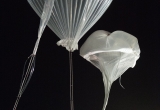The first PILOT flight was a success!
The stratospheric balloon carrying the PILOT instrument was launched from Timmins in Canada at 9 pm (local time) on Sunday, September 20th. The gondola, weighting more than a ton, the heaviest the CNES took in the last 25 years, was lifted by a stratospheric balloon of 800.000 m3 and reached the altitude of 39.500 m after 3 hours of ascent. After a last transfer of helium carried out just before take-off, the detectors reached nominally their operating temperature of 320 mK when the balloon reached its flight ceiling, and the scientific observations could then start.
During more than 20 hours, PILOT observed the far-infrared sky by means of its controlled pointing system, combining the azimuth motion (in rotation around the flight chain axis) with the elevation motion from the telescope itself. This pointing is then reconstructed with a very high accuracy, even in daylight, thanks to a stellar sensor, which was developed specifically for the PILOT project.
Thus, PILOT could measure the intensity and the polarization of several regions of the sky observable from the Northern hemisphere, including among others a part of the Galactic plane, Taurus, Orion, the Andromeda galaxy, pre-stellar formation cold cores, and very diffuse dust emitting regions. The latter allow us to understand the Galactic contribution to the polarized observations of the Cosmic Microwave Background.
On Monday, September 21st at 9 pm (local time), 24 hours after take-off, the CNES engineers triggered the separation of the gondola from the balloon. After the parachute descent, the gondola had a tough landing, because of significant ground gusts, in a wooded (but dry!) area. The gondola structure fully played its role in cushioning the impact with trees, so that the important parts of the payload were not damaged. Today, the instrument is on its way back across the Atlantic and, as soon as it will be back in early November, the rest of the diagnosis and tests on the cryostat and on the detectors will be carried out, in particular at IAS. These are the first stages in preparation for the PILOT second flight, scheduled from Australia in April 2017.
The balloon, the gondola, the pointing, the cryostat, the detectors, and the optics all behaved in a nominal way. Data analysis, which has started at IRAP and IAS, will allow us to produce the most complete and accurate maps of the dust polarization ever measured. These maps will make possible significant progress in our understanding of the cycle of matter and of the magnetic field of our own Galaxy. In addition, the observation of the Galactic emission at 240 µm (1250 GHz), combined with that of the Planck satellite at 850 µm (353 GHz), will improve our knowledge on the electromagnetic spectrum of the dust. This is a very important step towards the measurement of the Cosmic Microwave Background B-modes, as our recent publications, partly coordinated at IAS, on the Planck and BICEP2 data have demonstrated.
PILOT is a project developed by CNES in collaboration with CNRS laboratories (IRAP and IAS), Université Toulouse 3 Paul Sabatier, Université Paris Sud 11 and CEA, with contributions from the La Sapienza University in Rome and Cardiff University, under the scientific supervision of Jean-Philippe Bernard from IRAP.
IAS contacts: Jonathan Aumont, Jean-Pierre Dubois, François Boulanger
Photos and videos of the PILOT flight:
https://www.youtube.com/watch?v=qLdobPU1iFs
https://www.youtube.com/watch?v=bNXFmms7mH4
https://phototheque.cnes.fr/cnes/category/756
More information:
https://pilot.cnes.fr/fr/pilot
http://pilot.irap.omp.eu/PAGE_PILOT/index.html
[[{"type":"media","view_mode":"media_responsive","fid":"467","attributes":{"alt":"","class":"media-image","height":"1540","typeof":"foaf:Image","width":"1025"}}]]
Launch of PILOT. Copyright CNES.




